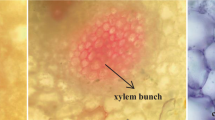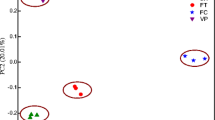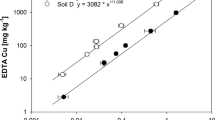Summary
Cucumber seedlings were grown in a Portsmouth soil-sand system to study how varying soil clay and organic matter content might modify cucumber seedling response to ferulic acid, a reported allelopathic agent. Leaf area expansion of cucumber seedlings, soil respiration, and soil solution concentrations of ferulic acid were monitored. Leaf area, mean absolute rates of leaf expansion, and shoot dry weight of cucumber seedlings were significantly reduced by ferulic acid concentrations ranging from 10 to 70 μg/g dry soil. Ferulic acid was applied every other day, since it rapidly disappeared from soil solution as a result of retention by soil particles, utilization by microbes and/or uptake by roots. The amount of ferulic acid retained (i.e., adsorbed, polymerized,etc.) by soil particles appeared to be secondary to microbial utilization and/or uptake by roots. Varying clay (5.3 to 9.8 g/cup) and organic matter (2.0 to 0.04g/cup) contents of the soil appeared to have little impact on the disappearance of ferulic acid from soil solution under “ideal” growth conditions for cucumber seedlings unless larger amounts of ferulic acid were added to the soil; in this case 200 μg/g. The addition of ferulic acid to the soil materials substantially increased the activity of the soil microbes. This latter conclusion is based on recovery of ferulic acid from soil solution and soil respiration measurements.
Similar content being viewed by others
References
Allison L E 1965 Organic carbon.In Methods of Soil Analysis. Ed. C A Black, (pp 1367–1378). Am. Soc. Agron. Inc., Madison, Wisconsin.
Bates-Smith E C 1956 The commoner phenolic constituents of plants and their systematic distribution. Proc. Roy. Dublin. Sci. Soc. 27, 165–176.
Blum U, Dalton B R and Rawlings R O 1984 Effects of ferulic acid and some of its microbial metabolic products on radicle growth of cucumber. J. Chem. Ecol. 10, 1169–1191.
Blum U and Dalton B R 1985 Effects of ferulic acid, an allelopathic compound, on leaf expansion of cucumber seedlings grown in nutrient culture. J Chem. Ecol. 11, 279–301.
Blum U, Dalton B R and Shann J R 1985 Effects of various mixtures of ferulic acid and some of its microbial metabolic products on cucumber leaf expansion and dry matter in nutrient culture. J. Chem. Ecol. 11, 619–641.
Blum U, Dalton B R and Shann J R 1985 The effects of ferulic and p-coumaric acids in nutrient culture on cucumber leaf expansion as influenced by pH. J. Chem. Ecol. 11, 1567–1582.
Dagley S 1971 Catabolism of aromatic compounds by microorganisms.In Advances in Microbial Physiology. Eds. A H Rose and J F Wilkinson, Vol. 6, pp. 1–46. Academic Press, London.
Dalton B R, Blum U and Weed S B 1983 Allelopathic substances in ecosystems: Effectiveness of sterile soil components in altering recovery of ferulic acid. J. Chem. Ecol. 9, 1185–1201.
Day P R 1965 Particle fractionation and particle-size analysis.In Methods of Soil Analysis. Ed. C A Black, pp 545–567. Am. Soc. Agro. Inc. Madison, Wisconsin.
del Moral R and Muller C H 1970 The allelopathic effects ofEucalyptus camaldulensis Am. Midl. Natur. 83, 254–282.
Evans W C 1963 The microbial degradation of aromatic compounds J. Gen. Microbiol. 32, 177–185.
Felbeck G T Jr 1971 Chemical and biological characterization of humic matter.In Soil Biochemistry. Eds. A D McLaren and J Skuljins, Vol 2, pp. 36–59. Marcel Dekker, New York.
Flaig W 1964 Effects of microorganisms in the transforation of lignin to humic substances. Geochem. Cosmochim. 28, 1523–1533.
Guenzi W D and McCalla T M 1966 Phytotoxic substances extracted from soil. Soil Sci. Soc. Am. Proc. 30, 214–216.
Haider K and Martin J P 1967 Synthesis and transformation of phenolic compounds byEpicoccum nigrum in relation to humic acid formation. Soil Sci. Soc. Am. Proc. 31, 766–772.
Hamaker J W and Thompson J M 1972 Physiochemical relationships of organic chemicals in soil: Adsorption.In Organic Chemicals in the Soil Environment. Eds. C A I Goring and J W Hamaker, pp 49–114. Marcel Dekker, New York.
Harper J P and Balke N E 1981 Characterization of the inhibition of K+ absorption in oat roots by salicylic acid. Plant Physiol. 68, 1349–1353.
Helwig J T and Council K A 1979 Users Guide, SAS Institute Inc., Cary, North Carolina.
Hoagland D R and Arnon D I 1950 The water-culture method of growing plants without soil. Calif. Agric. Exp. Stn. Circ. 347.
Huang P M, Wang T S C, Wang M K, Wu M K and Hsu N W 1977 Retention of phenolic acids by noncrystalline hydroxy-aluminium and-iron compounds and clay materials of soils. Soil. Sci. 123, 213–219.
Jackson M L 1969 Soil Chemical Analysis—Advanced Course, 2nd ed. 8th printing, 1973. Published by author, Department of Soil Science, University of Wisconsin, Madison, Wisconsin 53706.
Jenkinson D S and Powlson D S 1976 The effects of biocidal treatments on metabolism in soil V. A method for measuring soil biomass. Soil Biol. Biochem. 8, 209–213.
Lodhi M A K 1975 Soil-plant phytotoxicity and its possible significance in bottomland forest. Am. J. Bot. 62, 618–622.
Martin J P and Haider K 1976 Decomposition of specifically carbon-14-labeled ferulic acid: Free and linked into humic acid-type polymers. Soil. Sci. Soc. Am. J. 40, 377–380.
McPherson J K, Chou C-H and Muller C H 1971 Allelopathic constituents of the chaparral shrubAdenostoma fasciculatum. Phytochemistry 10, 2925–2933.
Patterson D T 1981 Effects of allelopathic chemicals on growth and physiological responses of soybean (Glycine max). Weed Sci. 29, 53–59.
Peech M, Dean L A and Reed J 1947 Method of soil analysis for soil fertility investigations. U. S. Dept. Agric. Circ. 757.
Rasmussen J A and Einhellig F A 1977 Synergistic inhibitory effects of p-coumaric and ferulic acid on germination and growth of sorghum. J. Chem. Ecol. 3, 197–205.
Rice E L 1984 Allelopathy. Academic Press, Orlando, Florida.
Shann J R and Blum U 1984 Depletion of ferulic acid, an allelopathic compound, by roots of cucumber seedlings. ASB Bull 31, 81.
Shann J R and Blum U 1985 Utilization of exogenous ferulic acid in lignin biosynthesis. Plant Physiol. 77, 140.
Shindo H and Kuwatsuka S 1976 Behavior of phenolic substances in the decaying process of plants. IV. Adsorption and movement of phenolic acids. Soil Sci. Plant Nutr. 22, 23–33.
Turner J A and Rice E L 1975 Microbial decomposition of ferulic acid in soil. J. Chem. Ecol. 1, 41–58.
Wang T S C, Li S W and Ferng Y L 1978 Catalytic polymerization of phenolic compounds by clay minerals. Soil Sci. 126, 15–21.
Wang T S C, Yang T and Chang T 1967 Soil phenolic acids as plant growth inhibitors. Soil. Sci. 103, 239–246.
Wang T S C, Yeh K-L, Cheng S-Y and Yang T-K 1971 Behavior of soil phenolic acids.In Biochemical Interactions Among Plants. Ed. U. S. Nat. Acad. Sci., Nat. Acad. Sci., pp 113–120. Washington, D.C.
Whitehead D C 1964. Identification of p-hydroxybenzoic, vanillic, p-coumaric and ferulic acids. Nature 202, 417–418.
Whitehead D C, Dibb H and Hartley R D 1981 Extractant pH and the release of phenolic compounds from soils. plant roots and leaf litter. Soil Biol. Biochem. 13, 343–348.
Whitehead D C, Dibb H and Hartley R D 1982 Phenolic compounds in soil as influenced by the growth of different plant species. J. Appl. Ecol. 19, 579–588.
Author information
Authors and Affiliations
Additional information
Paper No. 10347 of the Journal Series of the North Carolina Agricultural Research Service, Raleigh, N C 27695-7601. The use of trade names in this publication does not imply endorsement by the North Carolina Agricultural Research Service of the product named, nor criticism of similar ones not mentioned.
Rights and permissions
About this article
Cite this article
Blum, U., Weed, S.B. & Dalton, B.R. Influence of various soil factors on the effects of ferulic acid on leaf expansion of cucumber seedlings. Plant Soil 98, 111–130 (1987). https://doi.org/10.1007/BF02381732
Received:
Revised:
Issue Date:
DOI: https://doi.org/10.1007/BF02381732




